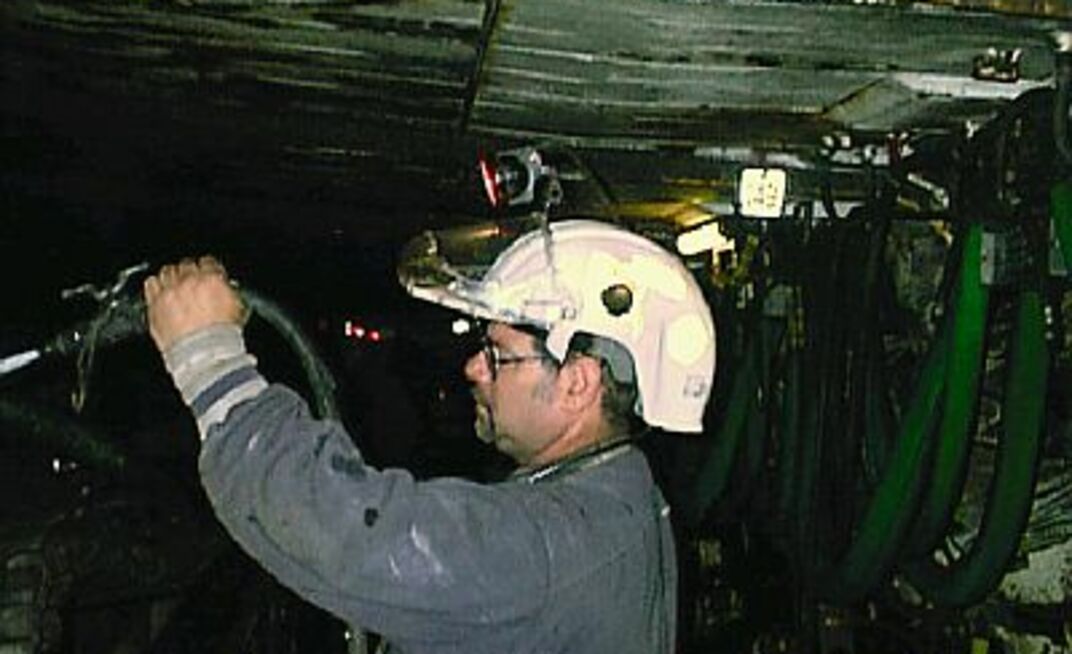Published in Australia's Longwalls
RAG’s Emerald mine is located in Waynesburg, Greene County, Pennsylvania, USA, and like many longwall mines clustered in the region mines the Pittsburgh No. 8 seam, which is between 1.5-2.1m (5ft-7ft) thick. The product is steam coal, approximately 13,000 British thermal units, 8% ash with a sulphur range of 2.2-3.5.
The Appalachian mine began increasing its face width in the latter half of 2003, going from an initial face width of 323m (1060ft) to 381m (1250ft). The mine is now well into the planning stages to push this out further to 442m (1450ft) by March 2005, with some hefty power requirements to support what will be one of the world’s widest faces.
In 2002 the mine produced 7.6 million raw tons (5.4 million clean tons) with three longwall moves. With its wider face the mine expects to be able to produce 6.8 million clean tons.
So far few problems have been encountered with the 381m face. In fact last year the two longwalls of Emerald and its neighbour Cumberland mined past each other in opposite directions, separated by a 69m barrier, said longwall manager Jim Myers.
“For a few passes we effectively had a face that was 600m wide. We didn’t see any problems in either the roof control or strata,” Myers said.
Emerald’s new mining area is the ‘B’ district with around 11 years of projected production, an estimated 4.5 million tons run of mine (ROM) per panel with average recoveries of 66-70%.
In the lead-up to the next jump in panel width the mine aims to bed down any technical issues related to the new 381m face.
The armoured face conveyor (AFC) chain size will need to increase from 42mm to 46mm and the mine is yet to decide whether to replace all the bottom decking on the pans to accommodate the 46mm chain, or buy a completely new system.
At the moment power to the face is supplied by two 1000hp motors at the headgate which have been bumped up to 1250hp for the 381m face. With the 442m face, modelling has indicated that two 1450hp motors will be required to drive this monster.
“Right now there are none of this size being run in the United States that we’re aware of,” Myers said. “All our major suppliers have stepped up to the plate and quoted us specs and pricing on developing that.”
Myers said the mine hoped not to go to the 65 series drive at the tailgate because of size and weight and operational challenges.
“We feel with the Controlled Start Transmissions (CST) drives and the software to adjust parameters we can make them compatible electronically.”
In recent years the mine has gone from strength to strength with major improvements in performance. In the last five years Emerald produced 23.5 million clean tons, slightly more than the 22.9 million tons it produced in the prior seven years.
The improvements are attributed to several factors, most importantly management philosophy and methodologies, according to Myers. These include process management, monitoring data, a philosophy of continuous improvement, and vendor alliances.
Regarding process management Myers had this to say: “Every job at Emerald has a way it is to be completed, and completed right the first time. This process is called standards. This allows for consistency in all jobs being performed and also allows for repetition of the process for monitoring and adjustments to the process as necessary.” According to Myers, it’s all about repetition.
Monitoring data in intricate detail is a key part of the program and allows trends to be observed and adjusted. All production and maintenance delays are recorded mine-wide by shift, delivering information for predictable and preventative maintenance and generating work orders for idle time.
“It provides information for cockpit charts used to monitor availability and trends of all machinery performance.”
Cost management is also crucial and systems are so refined they allow management to monitor costs on a daily basis against budget. Myers said the focus on cost was part of a general shift in philosophy among American coal producers away from simply producing volume.
“Now we aim to maintain our output at 6.5 million tons, but do it more cheaply so we don’t flood the market with coal and drive the price down.”
Emerald’s equipment line-up includes 216 DBT roof supports weighing in at 22 tons each, with a yield tonnage of 924 tons, at 1.75m centres. Four Kamat pumps provide 106 gallons per minute of fluid to the face and are powered by 350hp motors. Typically three pumps are used at any one time, with the fourth on stand-by.
The shearer is a Joy 7LS-2, upgraded from the 4LS in 2000. Cutting in bi-di, the shearer runs at an availability of 98% at a cutting rate of about 40ft per minute.
“We have had no motor failures throughout the panel, and component change-out has been reduced to one set of trapping shoes and usually one ranging arm cylinder per panel.”
Emerald has in place vendor alliances which Myers said had proven to be a valuable tool. The largest of these is with DBT. Speaking on vendor alliances Myers said there was usually no monetary or loss of production penalty. “We look for extended warranty life -- whatever it takes to make the system perform as advertised, at their cost.”
The main mechanism for nurturing the alliance is a monthly meeting, held between the mine management and DBT representatives. These are attended by a management representative from each of the mine’s departments such as maintenance, warehousing and accounting. DBT representatives attend from the original equipment manufacturer's (OEM) various business units such as conveyors, chains or software.
“We follow agendas and then try to solve any issues we have at that level. I would say probably 90% of issues we solve. If for some reason we can’t reach agreement we have global meetings where the next branch of senior management above us meet.”

























